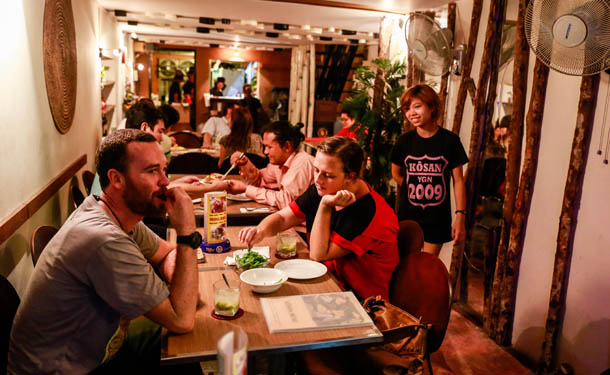Out of sight of most tourists’ cursory visits, Yangon’s Chinatown is where Myanmar meets its massive neighbor to the north, hundreds of kilometers from their nearest border crossing. As a cultural meeting place in the heart of Myanmar’s largest city, it is also, among other things, a culinary treasure-trove.
Every afternoon, hawkers with garlic fried chili crabs, steamed dim sum and straw baskets full of strawberries set up their shop around the Guanyin temple, bracing themselves for the onrush of evening strollers.
By the time the sidewalk spills into the street, the butcher at Good Diamond Sausages has sold out his daily output of pork sausages he says are made according to a recipe brought over from Guangdong in the 1940s. “They’re just a bit less sweet than in Hong Kong,” he says.
Most of Yangon’s Chinese population of about 150,000 still live in the area and most use Myanmar names and resort to the Myanmar language in their conversations. Men wear traditional longyi gowns and many waiters at Chinese restaurants are Myanmars. After decades of fearing a re-eruption of racial tensions, Yangon’s Chinese make a point of being Myanmar first, Chinese second.
Old, and some very new, wire fences around first and second floor windows show that concerns over long-simmering ethnic hatred haven’t faded.
Discovering how they preserve their heritage is becoming less of challenge. Chinese is once again the language to learn, and many young people speak crisp Putonghua along with the Cantonese, Hokkien or Fukkien dialects of their grandparents. The two bookstores that have Chinese books have put their money in schoolbooks; copycat DVDs of Chinese television series are sold near the Guanyin temple.
The foods that can be found on the streets of Chinatown are the strongest statement of a unique Chinese identity in Myanmar’s largest and most ethnically mixed city.
The Liangtai Lashio Broken Crisp Buns Restaurant on Latha Street, opposite the more crowded Cherry Crown Restaurant serving cold Myanmar Beer and Myanmar food, has the typical culinary compromise that makes Yangon’s Chinatown unique.
Steamed filled rice dumplings (200 kyat) are served cut into slices along with the typical Myanmar chili-tomato sauce wrongly called ketchup. The sweet buns with their savory fillings come with strong Myanmar black tea (200 kyat) made sweet and heavy by condensed milk.
Liangtai’s red and pink plastic stools are separated from traffic by a row of wooden deck chairs, where businessmen stop by for an hourly foot massage (4000 kyat), a cigarette (50 kyat) and a chat.
Angshandu, on a side street cornering to Guanyin temple, has Guangdong food with a Myanmar twist. Char siu pork comes with a spicy, peppery sauce and chicken broth. Stewed pork comes with chives and fragrant mushrooms. Hundun dumplings are either served in soup or cold in a bowl with shredded chicken or pork and crispy fried garlic.
On the other corner of the temple, rice porridge (500 kyat) is cooked every day in giant metal pots on carts. A bowl comes with fresh steamed blood, liver, fried garlic and chives. The zongzi, pyramid-shaped portions of steamed sticky rice with pork or chicken, sold wrapped in banana leaves and hanging from metal rods, (1,000 kyat) are a traditional dish eaten for the Dragonboat Festival on the fifth day of the fifth lunar month.
Nearby, elderly Ms Jiang sits on stool selling bright red and white sticky rice dough filled with sweet red bean paste or crushed peanuts. She also sells “tea cake,” an adapted version of Cantonese niangao sticky rice cake made with eggs and coconut milk. With a chop she has branded her shop’s calligraphic name on the sticky deserts.
By the time the stands are up outside Guanyin temple, the fortuneteller inside the temple has gone home for the day and young novice Buddhist monks play in its courtyard. 19th Street, just around the corner, will start filling up with tourists and locals coming for cheap beer and Yunnan-style barbecue.
Most of those expats who have been around a while end up at Kosan, not for the average food, but for the their Mandalay mojitos (800 kyat) made with Mandalay Rum, and to sit at their under-appreciated balcony, which looks down on the steaming pots and grills that feed the increasing stream of travelers to the once sleepy street.
The balcony looks down on the street in which, some 50 years ago, the Chinese embassy distributed little red books in a long-since forgotten effort to spread the Great Proletarian Cultural Revolution abroad.
New Chinese migrants settle around town. With soaring land prices, new immigrants seek their fortune in the suburbs, where land is affordable and shops are still few. Yangon’s Chinatown is the home of those who ventured to Myanmar when it was a different place.
This story appeared in the June 2013 print issue of The Irrawaddy magazine.

















